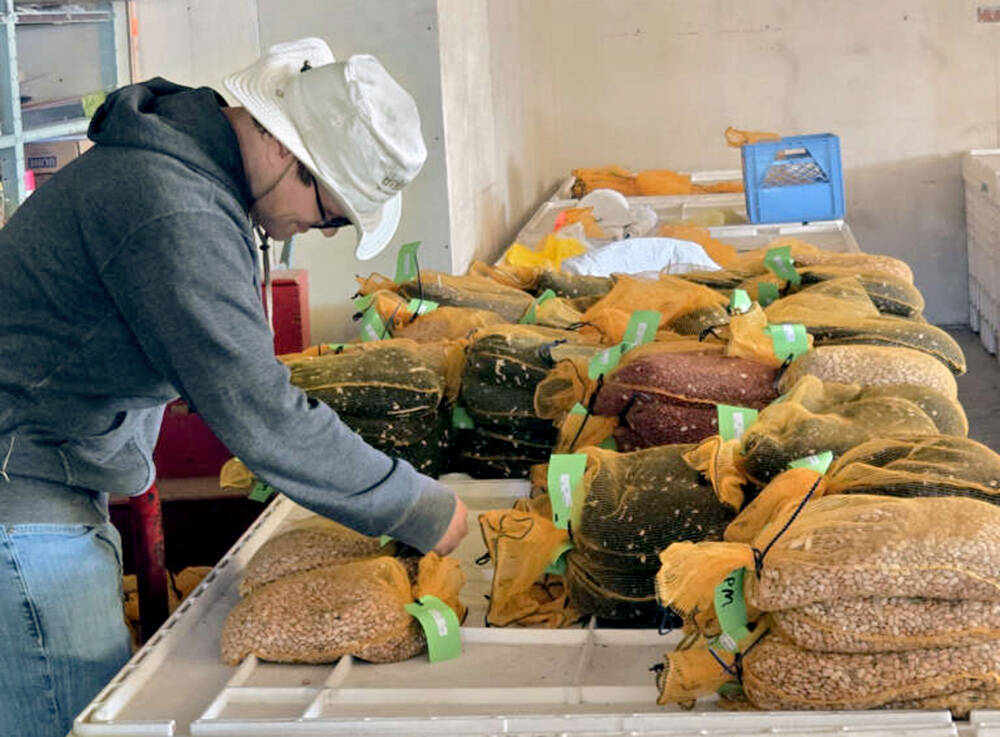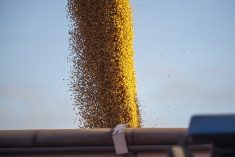Statistics Canada released its model-based crop survey Aug. 28. It adjusted planted acreage estimates and revised the previous year’s output.
Quick look
Soybeans: StatCan adjusted the planted area upward and yield is estimated at 51.1 bu./ac., the third highest on record.
Read Also

Bean research breeds community giving
University of Guelph dry bean researcher Dr. Mohsen Yoosefzadeh Najafabadi champions sustainability by donating surplus breeding program beans to support food security and community art initiatives.
Corn: Ontario crop size is estimated at 9.7 million tonnes.
Wheat: Export demand for Ontario feed wheat will be limited.
Ontario farmers are expected to harvest a record soybean crop. Corn yields will notch a fresh high of 180.1 bu./ac. but production will be down from last year due to a downward revision in planted area. Ontario corn and soybean prices are expected to make seasonal lows over the next month. Winter wheat prices are at seasonal lows.
Soybeans
According to Statistics Canada, Ontario farmers are expected to harvest 4.3 million tonnes of soybeans this fall. This compares to last year’s crop size of four million tonnes and the five-year average of 3.9 million tonnes. StatCan made an upward adjustment to the planted area, while yield was estimated at 51.1 bu./ac., the third highest on record. Ontario farmers are expected to deliver 3.4 million tonnes into the commercial system from Sept. 1 through Dec. 31.
For the first four months of the crop year, domestic crush is estimated at 600,000 tonnes. We’ve decreased our export projection from 1.7 million tonnes to 1.5 million tonnes. Total demand from Sept. 1 through Dec. 31 is estimated at 2.1 million tonnes. It’s important to note that the bulk of exports will occur in November and December.
The trade is expecting the U.S. soybean crop to finish in the range of 125-127 million tonnes, up from the 2023 crop of 113 million tonnes. U.S. farmers will be aggressive sellers at harvest, which will keep the futures market under pressure. U.S. producers are concerned about longer term trade retaliation from China if the next president imposes additional tariffs on Chinese products.
China was an aggressive buyer of U.S. soybeans throughout August. Prices f.o.b. the Gulf were quoted at US$390/tonne on Aug. 28, up $7/tonne from our previous issue. Brazilian offers were hovering at US$408/tonne f.o.b. Paranagua. Ontario soybeans were quoted at US$386/tonne f.o.b. St. Lawrence. China will continue to buy U.S. soybeans given the sharp discount to Brazilian origin.
South American farmers are making planting plans. Argentine farmers are expected to decrease corn acres by 30 per cent due to disease issues. These acres will be put into soybeans.
In Brazil, we’re expecting soybean acres similar to last year. The soybean market usually incorporates a risk premium in the early stages of South American crop development. The market will be more sensitive to weather this year due to lower Argentine acres.
What to do: We’ve advised producers to be 20 per cent sold on their 2024 production. The next recommendation will be in late November or early December. Producers need to wait until the North American harvest is completed and the market becomes nervous about South American production. Wait until Ontario exports improve, which will enhance the domestic basis.
Corn
Statistics Canada estimated the Ontario corn yield at 180.1 bu./ac., resulting in a crop size of 9.7 million tonnes. This compares to the 2023 crop size of 10 million tonnes and five-year average of 9.3 million tonnes. StatCan revised last year’s production while decreasing the planted area for 2024.
Farmer selling during the first four months of the crop year is expected to reach 6.5 million tonnes, while domestic demand is only 2.7 million tonnes. The domestic market will trade below world values to encourage offshore movement.
On Aug. 28, U.S. corn was offered at US$180/tonne f.o.b. the Gulf, unchanged from two weeks earlier. Brazilian corn was quoted at US$191/tonne f.o.b. Paranagua, matching offers from 14 days ago. The world market is making seasonal lows. Prices are expected to trade sideways over the next month and then start to percolate higher.
Ontario corn was quoted at US$190/tonne f.o.b. St. Lawrence. French corn was offered at US$230/tonne f.o.b. La Pallice.
French corn output is estimated at 13.5 million tonnes, up from 12.7 million tonnes last year. Traders are estimating U.S. corn output at 385-390 million tonnes, compared to the 2023 crop of 390 million tonnes.
Ontario values are competitive with French origin into Northern Europe. The key is that U.S. fobbing capacity in the Gulf will fill up during the fall. Once the U.S. has sold out fobbing capacity, Ontario corn will trade to traditional homes in Northern Europe. Ontario corn trades into Northern European ports in smaller vessels. Terminals in the U.S. Gulf focus on 50,000 tonne plus vessels.
Argentina will decrease corn acres this winter. The market will be very sensitive to Brazilian output. Keep in mind the bulk of the exportable surplus from Brazil only comes on the market in June.
What to do: We’ve advised Ontario farmers to be 30 per cent sold on their 2024 corn production. Our next sale will occur after the U.S. harvest has been completed and Gulf fobbing capacity fills up. The corn market makes seasonal highs in late November as U.S. export and domestic demand peaks in early December.
Wheat
Statistics Canada estimated the winter wheat crop at 2.4 million tonnes, up from our earlier estimate of 2.1 million tonnes. Although this is down from last year’s crop of 2.8 million tonnes, it’s above the five-year average of 2.3 million tonnes.
This year’s crop is composed of 1.8 million tonnes of milling quality and 800,000 tonnes of feed. This feed wheat will trade to Quebec and into local feed channels.
Export demand for Ontario feed wheat is limited. Milling wheat bids from Ontario and U.S. millers will be premium to the world market until later in fall. Once this domestic and U.S. demand is saturated, bids in Ontario will be dependent on export values.
Ontario farmers will sell two million tonnes of wheat from Aug. 1 through Dec. 31. We’re projecting Ontario on-farm wheat stocks at 400,000 tonnes on Dec. 31.
U.S. soft red winter wheat was quoted at US$215/tonne f.o.b. the Gulf. Ontario soft red winter was valued at US$210/tonne f.o.b. St. Lawrence port. The wheat market is in the process of making seasonal lows.
The Northern Hemisphere winter wheat harvest has been completed. Canadian, U.S. and Russian spring wheat harvests will be wrapped up by the end of September. Harvest selling pressure has evaporated and the market has breathing room to move higher. We’re expecting the milling wheat market to percolate higher over the next 45 to 60 days.
Russian wheat output will likely finish in the range of 80-83 million tonnes. Russian wheat exports are expected to decrease from 54 million tonnes in the 2023/24 crop year to 44 million tonnes in the 2024/25 campaign. The key is that Russian exports are front-end heavy. The exportable surplus will decline in the latter half of the crop year.
U.S. wheat export sales are running 33 per cent above year-ago levels. Lower production in Russia has caused an increase in U.S. and Canadian export sales.
What to do: We’re advising producers with feed wheat quality to be 50 per cent sold on their 2024 production. Producers with milling quality need to store their wheat until November. This is when we plan to make our first sale.
Canadian and U.S. wheat export demand makes seasonal highs in November. Given lower wheat prices in North America and Europe, we forecast a year-over-year decrease in winter wheat acreage in the U.S., Germany and France. We have to watch the weather and precipitation over the winter.
The market will garner upward steam in March and April, especially if adverse conditions materialize in Russia or the U.S.













